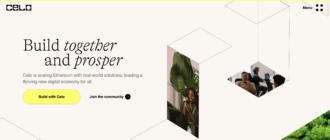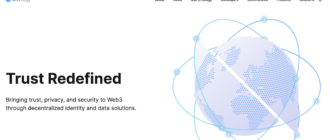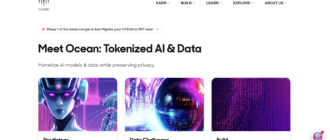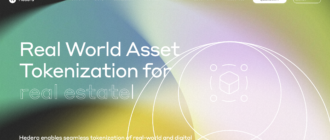Polygon, formerly known as Matic Network, is a multi-chain scaling solution for Ethereum, designed to provide faster and more economical transactions on the Ethereum blockchain. It addresses the issues of scalability and high transaction fees by creating a multi-layered platform that enables developers to build scalable user-friendly apps with low transaction costs.

History of the Project
Polygon was co-founded in 2017 by Jaynti Kanani, Sandeep Nailwal, and Anurag Arjun, along with Mihailo Bjelic who joined later. Originally launched as Matic Network, it underwent a rebranding to Polygon in February 2021, expanding its scope to create a multi-chain system akin to Polkadot on Ethereum. Key milestones include the initial exchange offering (IEO) on Binance in 2019 and the implementation of multiple technological innovations that have garnered significant interest from developers and investors alike.
What is Polygon?
Polygon is essentially a framework for building and connecting Ethereum-compatible blockchain networks. It combines the best of Ethereum and sovereign blockchains into a full-fledged multi-chain system. Polygon’s core component is Polygon SDK, a modular, flexible framework that supports building multiple types of applications. Its architecture aims to solve pain points associated with Blockchains, like high gas fees and slow speeds, without sacrificing security.
How the Polygon Project Works?
Polygon’s architecture is a sophisticated blend of a primary Ethereum layer, a security layer, Polygon networks layers, and an execution layer. Each component plays a crucial role in maintaining system integrity, speed, and flexibility. The foundation of Polygon’s unique structure is its construction on top of Ethereum, leveraging the existing network’s security and ecosystem.
Core Technologies and Their Roles
- Ethereum Layer: This layer functions as the base layer where all Polygon chains eventually settle their transactions. It utilizes Ethereum’s robust security and network effects while allowing Polygon to operate as a committed chain with added benefits.
- Security Layer: Operating as an optional layer, it provides “validators as a service,” offering an additional layer of security to chains that choose to use it. This layer works alongside Ethereum and can be seen as an added security measure, enhancing the security of blockchains that opt into this service without requiring them to start from scratch.
- Polygon Networks Layer: This is where the multiple blockchain networks built using Polygon’s technology reside. These chains can interact with one another and with the Ethereum main chain, supporting a variety of consensus mechanisms and governance models, tailored to the needs of specific projects.
- Execution Layer: Implemented via the Polygon SDK, this layer is crucial for executing smart contracts and managing transaction processing. The SDK supports building standalone chains or secured chains which can have their own validators or use the security layer.
Blockchain Technology and Consensus Mechanism
Polygon’s primary consensus mechanism is a modified Proof of Stake (PoS) system that offers several improvements over traditional PoS models. The network utilizes a set of validators that are staked with MATIC tokens to ensure the fidelity of the transaction processes. Validators participate in the consensus process by validating blocks and committing checkpoints to the Ethereum main chain. This structure reduces the transaction validation times drastically and increases the number of transactions that can be processed on the network.
The use of checkpoints, where block hashes are periodically submitted to Ethereum, is a unique feature. These checkpoints allow the main Ethereum chain to keep an accurate record of Polygon’s state without managing every transaction, thereby offloading the computational burden without compromising security.
Technical Details and Differentiators
Polygon differentiates itself with a flexible and modular framework called the Polygon SDK. This SDK allows developers to create custom blockchains tailored to specific needs. For instance, developers can choose between various scaling solutions such as zkRollups or Optimistic Rollups based on their requirements, balancing between speed and security.
Furthermore, Polygon’s ability to work as a multi-chain system with interoperable blockchains under the Ethereum network is a significant distinction from other scaling solutions. This interoperability is facilitated by Polygon Bridge, a framework enabling assets to be moved between the Ethereum blockchain and various Polygon chains seamlessly. This feature not only enhances user experience by simplifying interactions across platforms but also increases the overall efficiency of the network.
In summary, Polygon’s technological foundation is built on a unique combination of Ethereum’s security and an innovative multi-layer system that supports a wide range of decentralized applications, making it a versatile and powerful solution in the blockchain scalability space.
What is Polygon SDK?
Polygon SDK is the cornerstone of the Polygon network, designed as a versatile and modular framework for building and connecting Ethereum-compatible blockchain networks. This toolkit is central to enabling a wide array of applications, from entirely new blockchain architectures to specific solutions for developers looking to scale or enhance their existing dApps.
Architecture and Components
The Polygon SDK is structured to support the creation of two primary types of solutions: standalone chains and secured chains. Standalone chains are self-sovereign blockchain networks that leverage their own security mechanisms and are fully in control of their consensus and governance models. Secured chains, on the other hand, rely on the security services provided by the Polygon network or directly from Ethereum, making them akin to layer-2 solutions.
Key Features and Functionalities
- Modularity: The SDK is highly modular, allowing developers to plug in or swap out various components such as consensus algorithms or storage engines. This modularity ensures that developers can customize their networks to fit specific needs without being locked into a one-size-fits-all solution.
- Interoperability: Through the SDK, Polygon facilitates seamless interoperability among various blockchain networks. It supports the creation of multi-chain architectures, where different chains can communicate and operate together under the Polygon umbrella, all while maintaining compatibility with Ethereum.
- Scalability: By supporting multiple scaling solutions like zkRollups and Optimistic Rollups, the SDK addresses one of the most significant issues facing the Ethereum network today: scalability. These technologies allow for executing transactions off the main Ethereum chain, thereby reducing congestion and gas fees.
- Security: For chains that require additional security beyond what their native mechanisms can provide, the Polygon SDK allows for the implementation of a shared security model. This model means multiple chains can pool their security resources, benefiting from a collective security framework which is particularly useful for smaller or newer projects with limited resources.
- Developer Tools: Polygon SDK comes equipped with a range of tools designed to simplify the process of developing, deploying, and managing decentralized applications (dApps). These tools include pre-built plugins for common tasks, comprehensive documentation, and a supportive community of developers.
Strategic Importance
The SDK’s ability to create both standalone and secured chains provides a flexible platform for innovation within the blockchain space. By lowering the barriers to entry for creating Ethereum-compatible networks and enhancing the capabilities of existing Ethereum applications, Polygon SDK plays a crucial role in the broader ecosystem. It not only promotes developer activity and diversity in blockchain solutions but also enhances the overall value proposition of the Ethereum network by addressing key challenges such as scalability and interoperability.
In essence, Polygon SDK is a powerful toolkit that empowers developers to build scalable, efficient, and interconnected blockchain networks, driving forward the vision of a more accessible and robust decentralized future.
Tokenomics of the Polygon Project
MATIC, the native asset of Polygon, is a utility token that plays a multifaceted role within the network’s ecosystem. Designed to operate within the Ethereum infrastructure, MATIC is not just a cryptocurrency but a token that facilitates the operation and governance of the Polygon platform.
Token vs. Coin
MATIC is technically a token, not a coin, because it operates on top of the Ethereum blockchain as an ERC-20 token, rather than having its own independent blockchain. As such, MATIC leverages the security and ubiquity of Ethereum while enabling transactional and operational efficiencies on the Polygon network.
Token Emission Model
The total supply of MATIC tokens is capped at 10 billion, with a strategic emission schedule designed to support network growth and development. The initial allocation of tokens was distributed as follows: 16% to the team, 4% to advisors, 12% to the foundation, 21.86% was sold during the launch events, and the remainder is reserved for network operations, staking rewards, and ecosystem development.
Token Utility and Staking
MATIC tokens serve several key functions:
- Transaction Fees: MATIC is used to pay for transaction fees on the Polygon network, which are significantly lower than those on the main Ethereum network.
- Staking: Token holders can stake their MATIC to participate in the network’s Proof of Stake consensus mechanism. Stakers help secure the network and process transactions, and in return, they receive staking rewards derived from transaction fees.
- Governance: MATIC holders can vote on Polygon Improvement Proposals (PIPs), influencing the development and operational aspects of the network.
Economic Incentives and Deflationary Mechanisms
Polygon employs a deflationary tokenomics model, where a portion of transaction fees are burned. This burn mechanism is intended to reduce the overall supply of MATIC over time, potentially increasing its value as the network’s usage grows. The balance between staking rewards and token burns is carefully managed to ensure long-term sustainability and encourage active participation by validators and users.
Market Performance
MATIC’s market price is subject to volatility typical of cryptocurrencies but has shown resilience and growth as Polygon’s platform has expanded its user base and application scenarios. The token’s value reflects the demand for cheaper and faster transactions in the Ethereum ecosystem, as well as the broader market sentiment towards crypto assets and blockchain technology.
The tokenomics of MATIC are intricately designed to align with the goals of the Polygon network, promoting security, scalability, and active community governance. The thoughtful emission schedule and economic incentives ensure that the network remains secure and efficient while fostering a robust ecosystem around Polygon’s scaling solutions.
Where to Buy the MATIC Token?
MATIC tokens are widely available on several prominent cryptocurrency exchanges, making them accessible to a broad range of investors and users. Here are some recommended exchanges where you can purchase MATIC:
- Binance: One of the largest and most well-known cryptocurrency exchanges globally, Binance offers high liquidity and multiple trading pairs for MATIC, including MATIC/USDT, MATIC/BTC, and MATIC/BNB.
- HTX (formerly Huobi): Known for its robust security features, HTX provides a reliable platform for buying and selling MATIC, with support for various fiat and cryptocurrency pairs.
- MEXC: This exchange is known for its wide selection of cryptocurrencies, including MATIC. It offers competitive trading fees and a user-friendly interface for both novice and experienced traders.
- Bybit: Bybit supports MATIC trading and is praised for its intuitive platform and strong emphasis on trader education and tools.
- KuCoin: Often referred to as “the people’s exchange,” KuCoin offers MATIC trading with good liquidity and low fees, suitable for both beginners and experienced traders.
- Bitfinex: This exchange, known for serving more advanced traders, offers several MATIC pairs and provides robust trading features.
When purchasing MATIC, it is essential to consider factors such as liquidity, fees, and the security measures of the exchange.
Where to Store the MATIC Token?
For storing MATIC tokens, it’s crucial to choose wallets that provide not only security but also ease of access and compatibility with the Ethereum network. Here are some of the recommended wallets:
- MetaMask: This is a popular Ethereum wallet that supports ERC-20 tokens, including MATIC. MetaMask is available as a browser extension and a mobile app, making it convenient for interacting with decentralized applications directly.
- Trust Wallet: A mobile wallet that offers support for MATIC and other cryptocurrencies. It provides an intuitive interface and robust security features, making it suitable for on-the-go use.
- Ledger Nano X/S: For those who prefer hardware wallets, the Ledger Nano series supports MATIC by integrating with Ledger Live alongside other third-party wallet interfaces.
- Trezor: Another secure hardware wallet option that supports MATIC through third-party interfaces like MetaMask, providing an additional layer of security by storing tokens offline.
- Polygon Wallet: Designed specifically for the Polygon network, this wallet facilitates direct interaction with Polygon’s Layer 2 scaling solutions and offers features tailored to the network’s ecosystem.
Each of these wallets provides unique features such as integration with decentralized applications, security layers, and user-friendly interfaces, catering to various needs and preferences of MATIC token holders. Whether opting for a hardware wallet for maximum security or a software wallet for convenience, it’s important to follow best practices for security, like keeping recovery phrases secure and conducting transactions in secure environments.
Future Prospects and Development Forecast
Polygon’s growth is driven by its robust technological foundation, strategic partnerships, and the growing need for scalable blockchain solutions. As Ethereum continues to face challenges related to scalability and transaction costs, Polygon’s solutions offer a compelling alternative that enhances Ethereum’s capabilities without sacrificing security or decentralization. The rise in decentralized finance (DeFi), gaming, and non-fungible token (NFT) sectors, all of which require the type of fast and low-cost transactions that Polygon can provide, further fuels this growth.
Clients and Partners
Polygon has formed partnerships with numerous key players across different sectors, which not only enhances its credibility but also widens its use case applicability. Some notable partners include:
- Infosys: This collaboration involves exploring scalable solutions for Ethereum’s congestion and high fees.
- Google Cloud: Polygon’s datasets are integrated with Google Cloud’s BigQuery, facilitating easier access and analysis, which is crucial for developers and businesses using the network.
- Decentraland: A virtual reality platform where Polygon helps manage a decentralized virtual goods economy.
- OpenSea: The largest NFT marketplace that uses Polygon to offer a gas-free marketplace layer, enhancing user experience and accessibility.
- Aavegotchi: A DeFi-staked NFT game operating on Polygon, showcasing its capability to support complex economic models within games.
These partnerships underline Polygon’s utility and versatility, spanning various applications from enterprise solutions to entertainment and finance.
Development Forecast
The development trajectory of Polygon looks promising, with plans to further enhance its infrastructure to support more high-speed, secure applications. Continued adoption by DeFi platforms and expansion into emerging areas like decentralized social media and enterprise blockchain solutions are expected. Furthermore, as more developers and businesses adopt its scaling solutions, network effects are likely to accelerate growth.
Ecosystem
Polygon’s ecosystem comprises a wide range of applications built on its network, which not only demonstrates its capability but also its adaptability to different blockchain needs. The ecosystem includes:
- DeFi platforms such as QuickSwap, Uniswap, and Balancer, which leverage Polygon for its high-speed and low-cost transactions.
- Gaming and NFT platforms like Aavegotchi, Zed Run, and Neon District, which utilize Polygon to enhance user experience with faster transaction times and reduced costs.
- Enterprise solutions that use Polygon’s technology to deliver blockchain solutions that require scale, speed, and security without high costs.
This diverse ecosystem is a testament to Polygon’s flexibility and effectiveness in addressing a broad array of blockchain applications, ensuring its relevance and sustained growth in the blockchain space.
Conclusion
Polygon stands out as a transformative project in the blockchain space, aimed at resolving the pressing issues of scalability and usability of Ethereum. With its robust technology stack and strategic vision, Polygon is well-equipped to play a significant role in the future of blockchain and decentralized applications. As the crypto and blockchain landscape evolves, Polygon is likely to continue influencing both technological advancements and market dynamics significantly.






